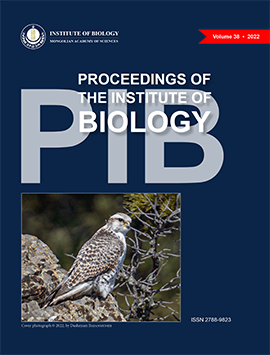Expression of p53 and beta-catenin proteins in hepatocellular carcinoma
DOI:
https://doi.org/10.5564/pib.v38i1.2545Keywords:
mutation, tumor, western blotAbstract
The expression of p53 and beta-catenin proteins in hepatocellular carcinoma (HCC) samples with mutations in the tumor suppressor TP53 gene, which has a high frequency of mutations in liver cancer, and the CTNNB1 gene, which plays an important role in the Wnt signaling pathway, were identified. As a result, the beta-catenin protein was increased in 83.33% of liver tumor samples with CTNNB1 gene mutation, and p53 protein expression was increased in 50% of samples with TP53 gene mutation. According to this, it may be that liver tumors were caused by changes in p53 and beta-catenin protein expression.
Элэгний хорт хавдрын эсийн p53, бета-катенин уургийн экспресс
Элэгний хорт хавдрын мутацийн өндөр давтамжтай тохиолддог хавдар дарангуйлагч ТР53 ген болон Wnt дохиоллын замд чухал үүрэгтэй оролцдог CTNNB1 генийн мутаци илэрсэн элэгний хавдрын дээжүүдэд уургийн (p53, бета катенин) нийлэгжлийг вестерн блотын аргаар судлав. Судалгааны дүнд CTNNB1 генийн мутацитай элэгний хавдрын дээжүүдийн 83.33%-д бета-катенин уураг, ТР53 генийн мутацитай дээжүүдийн 50%-д р53 уургийн нийлэгжил тус тус нэмэгдсэн байв. Үүнээс үзэхэд p53 болон бета-катенин уургийн нийлэгжлийн өөрчлөлтөөр элэгний хавдар үүссэн байх магадлалтай.
Түлхүүр үгс: мутаци, хавдар, вестерн блот
Downloads
400
References
“Liver cancer statistics,” World cancer research fund international, 2020. https://www.wcrf.org/cancer-trends/liver-cancer-statistics/
Ding et al., “Precision medicine for hepatocellular carcinoma: driver mutations and targeted therapy,” Oncotarget, vol. 8, no. 33, pp. 55715–55730, 2017, https://doi.org/10.18632/oncotarget.18382.
Tornesello et al., “Mutations in TP53, CTNNB1 and PIK3CA genes in hepatocellular carcinoma associated with hepatitis B and hepatitis C virus infections,” Genomics, vol. 102, no. 2, pp. 74–83, 2013, https://doi.org/10.1016/j.ygeno.2013.04.001.
MacDonald et al., “Wnt/β-Catenin Signaling: Components, Mechanisms, and Diseases,” Dev. Cell, vol. 17, no. 1, pp. 9–26, 2009, https://doi.org/10.1016/j.devcel.2009.06.016.
Kim et al., “Promotion of growth factor signaling as a critical function of β-catenin during HCC progression,” Nat. Commun., vol. 10, no. 1, p. 1909, 2019, https://doi.org/10.1038/s41467-019-09780-z.
Paek et al., “Cell-to-Cell Variation in p53 Dynamics Leads to Fractional Killing,” Cell, vol. 165, no. 3, pp. 631–642, 2016, https://doi.org/10.1016/j.cell.2016.03.025.
Sano et al., “Disruptive TP53 mutation is associated with aggressive disease characteristics in an orthotopic murine model of oral tongue cancer,” Clin. Cancer Res. Off. J. Am. Assoc. Cancer Res., vol. 17, no. 21, pp. 6658–6670, 2011, https://doi.org/10.1158/1078-0432.CCR-11-0046.
Gao et al., “Exon 3 mutations of CTNNB1 drive tumorigenesis: a review,” Oncotarget, vol. 9, no. 4, pp. 5492–5508, 2017, https://doi.org/10.18632/oncotarget.23695.
Downloads
Published
How to Cite
License
Copyright (c) 2022 Enkhtuya Ariya, Buyanbat Khurelsukh, Ganbat Sondor, Enkhbaatar Ankhbayar, Baatarjav Gan-Erdene, Nanzaddorj Taivan, Davaakhuu Gantulga, Tsendsuren Oyunsuren

This work is licensed under a Creative Commons Attribution-NonCommercial 4.0 International License.
Copyright on any research article in the Proceedings of the Institute of Biology is retained by the author(s).
The authors grant the Proceedings of the Institute of Biology license to publish the article and identify itself as the original publisher.
![]()
Articles in the Proceedings of the Institute of Biology are Open Access articles published under a Creative Commons Attribution-NonCommercial 4.0 International License - CC BY NC.
This license permits use, distribution and reproduction in any medium, provided the original work is properly cited.




